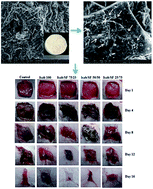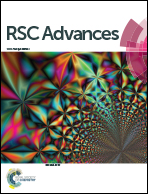Isabgol–silk fibroin 3D composite scaffolds as an effective dermal substitute for cutaneous wound healing in rats
Abstract
Composite 3D scaffolds using a natural, carbohydrate polymer, isabgol (Isab) and silk fibroin (SF) were prepared by a freeze drying method. 2 wt% solutions of both Isab and SF were blended in four different ratios to obtain the 3D scaffolds. ATR-FTIR results showed the presence of amide bonds and β sheet conformation in Isab/SF scaffolds. SEM micrographs showed the fibrous foam like architecture in the Isab/SF blend. Scaffolds showed sufficient porosity and absorbed higher amounts of PBS solution, enhancing the gas and nutrient supply to the cells. Subsequently, scaffolds showed significant in vitro biodegradation. In vitro cytocompatibility test in NIH 3T3 fibroblast cells showed better viability, proliferation and cell attachment for the Isab/SF 75/25 scaffolds compared to the control. Among all the scaffolds, Isab/SF 75/25 showed a faster wound contraction rate (p < 0.001) and reduced period of epithelialization (16 days) compared to the control (23 days). Shrinkage temperature and collagen content was also increased significantly (p < 0.001) in Isab/SF 75/25 scaffold treated rats compared to the control. Histopathology results strongly demonstrate higher cellular infiltration, increased fibroblasts, dense collagen fibers, and neovascularization in Isab/SF 75/25 treated rats, compared to other treatments. Overall, these results strongly authenticate that the Isab/SF 75/25 3D composite scaffolds enhanced the fluid uptake ability with enough fibroblast attachment and good viability. Also, it accelerated tissue regeneration during wound healing in rats without addition of any bioactive molecules.


 Please wait while we load your content...
Please wait while we load your content...